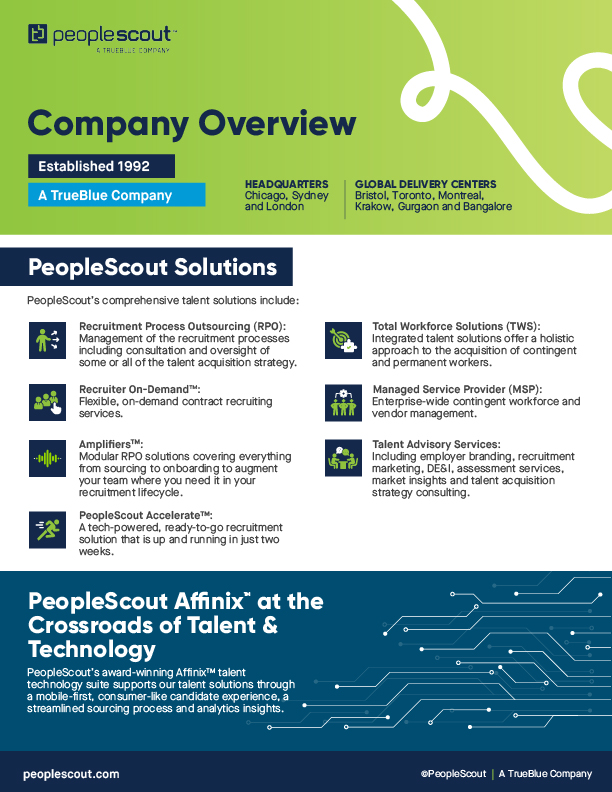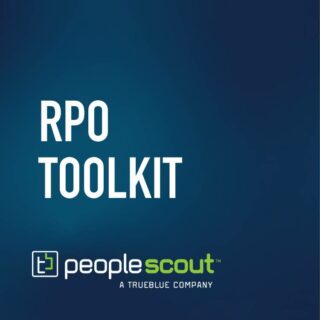TACOMA, Wash., June 17, 2024 /PRNewswire/ — TrueBlue (NYSE: TBI), a leading provider of specialized workforce solutions, today announced that its global talent solutions brand, PeopleScout, has been named a global Leader in leading research firm Everest Group’s 2024 Recruitment Process Outsourcing (RPO) Services PEAK Matrix® Assessment for the sixth consecutive year.
“PeopleScout’s steady geographic expansion and expertise in hiring for a wide variety of roles across healthcare, retail, and manufacturing industries have enabled it to develop a comprehensive value proposition for RPO buyers,” said Arkadev “Arko” Basak, Partner, Everest Group. “Its recent launch of tech-driven agile and modularized RPO solutions, as well as continued investments in its talent advisory and proprietary Affinix technology platform, have helped it to maintain its position as a Leader in Everest Group’s Recruitment Process Outsourcing (RPO) Services PEAK Matrix® Assessment 2024 – Global.”
Everest Group classifies RPO service providers into three categories: Aspirants, Major Contenders and Leaders, the highest designation. The firm’s proprietary PEAK Matrix® characterizes Leaders as being ahead of the curve in “demonstrating strong vision and capability to support their clients” and at the forefront of “investing in developing emerging capabilities, including consulting, value-add services, skill-based support and generative AI.” Leaders are also selected for their multi-regional capabilities and significant global presence.
“We are honored to again receive a Leader distinction from Everest Group, which is a direct reflection of the continued dedication and best-in-class service our team delivers every day,” said Rick Betori, President of PeopleScout and EVP of TrueBlue. “As we forge stronger connections throughout the talent ecosystem with our best-fit technology, scalable offerings and unrivaled in-house talent advisory expertise, we remain unwavering in our commitment to building sustainable talent strategies that drive results and improve business outcomes for our clients.”
Everest Group’s assessment of PeopleScout on this year’s PEAK Matrix® highlighted the following key strengths:
- PeopleScout has significant global capabilities, with proven expertise supporting large and mid-size enterprises across a variety of sectors, with solutions rooted in their partnership-led approach.
- PeopleScout recently launched two agile RPO offerings in response to evolving buyer demands:
- PeopleScout Accelerate™, a tech-enabled, quick implementation RPO solution.
- PeopleScout Amplifiers™, a suite of modular talent solutions, providing customizable and stand-alone services for talent mapping, talent sourcing, Recruiter On-Demand™, candidate assessments, and onboarding and retention.
- PeopleScout continues to invest in its proprietary and cloud-based technology platform Affinix™, which offers functionality across the talent acquisition spectrum, from candidate sourcing and matching to customized reporting and analytics.
- PeopleScout’s talent advisory services include consulting and value-added services across employer branding, recruitment marketing strategy and activation, talent insights and workforce planning, DE&I strategy and candidate assessments.
- By capitalizing on its contingent talent acquisition capabilities and technology, PeopleScout successfully delivers total talent solutions, and helps buyers with early careers hiring and high-volume recruitment.
Everest Group’s research is based on three key sources of information, updated annually: its database of approximately 6,400 RPO deals, the operational capability of the 50+ assessed RPO service providers, and buyer references interviews and ongoing buyer surveys and interactions. The analyses in the report are presented at two levels: overall market analysis and current market trends based on deal activity in the last five years.
To learn more about the RPO Services PEAK Matrix® Assessment 2024, visit the Everest Group website.
About PeopleScout
PeopleScout, a TrueBlue (NYSE: TBI) company, is a global talent solutions leader that provides unmatched scalability to meet the hiring needs of organizations of all sizes. It connects clients with top talent through Recruitment Process Outsourcing (RPO), Managed Service Provider (MSP), Total Workforce Solutions, and talent and technology advisory services. PeopleScout is helping talent leaders harness the power of data, drive decisions and exceed expectations through tech-charged solutions founded on machine learning and AI. PeopleScout’s legacy of service and partnership has led to consistent recognition as a leader by industry analysts. For more information, visit peoplescout.com.
About TrueBlue
TrueBlue (NYSE: TBI) is a leading provider of specialized workforce solutions that help clients achieve business growth and improve productivity. In 2023, TrueBlue served 67,000 clients and connected approximately 464,000 people to work. Its PeopleReady segment offers on-demand, industrial staffing; PeopleScout offers recruitment process outsourcing (RPO) and managed service provider (MSP) solutions to a wide variety of industries; and PeopleManagement offers contingent, on-site industrial staffing and commercial driver services. Learn more at trueblue.com.








